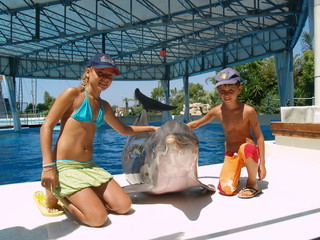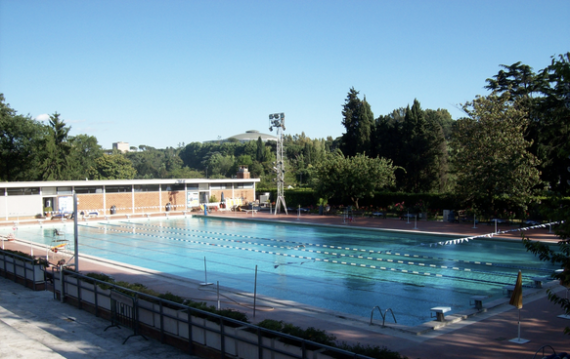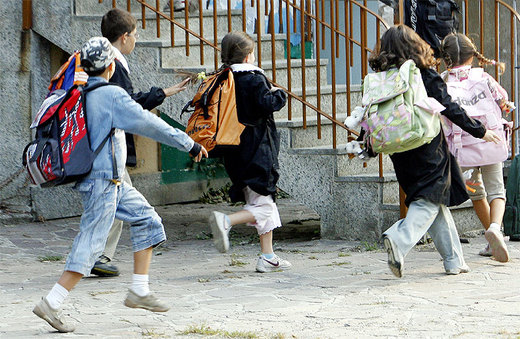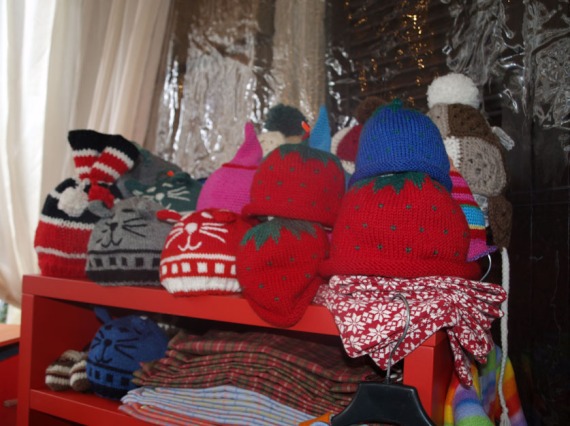Ciao, Kids!
Are you enjoying the city, with its majestic monuments, shiny cobblestones and great food? Are you having fun discovering ancient Rome?
But do you get to choose, and have your say in where to go and what to see?
[tweetmeme source=”passerotto” only_single=false]
If you’re tired of grown-ups deciding your itinerary, bored of hearing them read dates and facts off guidebooks, maybe you should suggest visiting some places they might not be familiar with; and become the guide yourself for the day.
In addition to the remarkable artistic, historic and architectural wonders your parents will want to share with you–to bring more variety to your Rome experience–here are a few more sites you might like to tell them about.

Big Bambù in Testaccio ©EleonoraBaldwin
Big Bambù | Suspended Bamboo Forest
The iconic symbol for the flourishing Testaccio neighborhood is 33 meters high and is located within the stockyards of the city’s former slaughterhouse. The project designed by brothers Mike and Doug Stern required the efforts of 15 American and 10 Italian rock climbers, who built the elevated space in 2012, and which is integrated within the flexible bamboo framework. Big Bambù, with its double helix staircase and various labyrinth paths that lead the visitors up over two ‘living rooms’, allows 80 to 120 visitors at a time, who are free to wander and relax in the suspended rest areas, terraces and intricate paths. The thousands of bamboo rods are connected and interlocked with a traditional yarn bombing-like weaving method, which generates a wonderfully chaotic network of unpredictable intersections and outlooks.
Access to Big Bambú requires signing a waiver and adequate shoes (no heels, no sandals, and possibly with a non-slip sole). No admittance in case of rain. Open daily from 4 to 9pm.
MACRO Roma – Piazza O. Giustiniani 4 | Tel. +39 06 671070400 | Free admission
Planetario e Museo Astronomico di Roma | Rome Planetarium and Astronomical Museum
The Planetarium is a fascinating place. To get there, you need to travel south, away from the city center. You can do this by taking the subway Line B, and getting off at the Laurentina stop. You’ll find yourself in a perfectly modern and geometric part of the city, this is the Ancient Rome-inspired fascist era district called EUR. The Rome Planetarium observatory sits under a spectacular 46-foot dome and seats 100 people in comfortable reclining padded chairs. These recline so that when the show starts, you can relax and enjoy the projection of 4,500 stars on the dome’s inner screen. It takes five slide projectors to simultaneously beam the planet images, and twelve for the background constellations. Besides visiting the Astronomical Museum, the Planetarium organizes shows for groups and schools and combines visits to the neighboring Museo della Civiltà Romana. Shows last 20 minutes.
Planetarium – Piazza Giovanni Agnelli 10 | Tel. +39 06 0608 | Free admission for children under 6
Cripta della Chiesa dei Cappuccini | Skulls and bones galore
Older kids will love this place, but younger ones may get scared, so tell your parents about this visit before dragging the entire family there.
The Capuchin Crypt is a small space made up of several small chapels located beneath the church of Santa Maria della Concezione dei Cappuccini on the Via Veneto, near Piazza Barberini. It is the final resting place for over 4,000 Capuchin friars, who died between the 1500s and the 1800s, as well as several Romans. Curiously, many of the bones are nailed to the walls in intricate patterns, many are piled high among many others, and some hang from the ceiling as functioning light fixtures. The rooms in the crypt feature unique displays of human bones. The thousands of human skulls and bones are arranged in fact in many different and impressive decorating shapes reproducing everyday objects and furnishings, which make this a must on your Rome visit. The crypt is structured in a line of six adjoining room; this makes it easy to visit without running the risk of getting lost. Opening hours: 9 a.m. to 12 noon – 3 p.m. to 6 p.m. | Closed Thursdays | There is no entrance fee, but you can make a small donation. No photography is allowed. Be sure to buy some postcards to bring back home and freak out your friends.
www.cappucciniviaveneto.it
The Church of Santa Maria della Concezione dei Cappuccini sits across the street from the Via Veneto exit of the Line B subway stop “Barberini,” and only a few steps away from the Hard Rock Cafe… jussayin’.
Bocca della Verità | Ultimate “Truth or Dare”
Walk along Via del Teatro di Marcello from the Campidoglio, and before hitting the grand Circus Maximus, on the left you’ll reach the church of Santa Maria in Cosmedin, which is famous for its special mosaics, Romanesque bell tower and the Bocca della Verità, the Mouth of Truth. This is, plainly, a lie detector. The Mouth is located in the courtyard outside the church, and you will recognize it immediately. It is a large, round stone face with its mouth open. Ready to put your hand in the mouth? If you haven’t told any lies, everything will be fine… otherwise, the Mouth will know it and chomp off your hand! But don’t worry, this mouth was actually – along with Via del Babuino’s, and Piazza Pasquino’s famous armless tenants – one of Rome’s many “talking statues.” Roman tradition prescribes that protestors may place a written complaint referring to religious or governmental officials by lodging an accusatory poem on the base of the statue, or in this case in the Bocca’s open mouth. If you look closely at the Bocca della Verità, you can see there are two claws, similar to a crab’s, hidden in its curly hair. The mask represents the sea-god Neptune and we all know he prefers to eat fish!
Basilica of Santa Maria in Cosmedin – Via della Greca, 4 | Tel. +39 06 6793609 | Open daily until 5pm
Knights of Malta | Peeking through a Keyhole
>High on the Aventine Hill, via di Santa Sabina and Via Porta Lavernale both open onto the quiet Piazza dei Cavalieri di Malta. Bordered by a high wall, decorated with obelisks and military trophies, it leads to a famous and fascinating broad and dark wooden door, which is always shut. Known affectionately as the “hole of Rome” the enduring attraction draws visitors to this empty piazza. No key is required: all you have to do is put an open eye to the keyhole, and focus. A vision of St. Peter’s dome perfectly in perspective, framed by trees in the foreground, opens up. The glinting white dome – often wrapped in a thin mysterious mist – looks like it’s standing at the end of the garden path, just beyond the door; when it is instead several miles away. The huge doorway famous for the keyhole is the mighty entrance to the headquarters of the Sovereign Order of the Knights of Malta.
Leaning forward and taking a peek at il Cupolone, simply the dome – as we call it here – through one of Rome’s most prohibited locations, is a definite must on your Rome visit. The show through the keyhole is one hardly forgettable.
Piazza dei Cavalieri di Malta
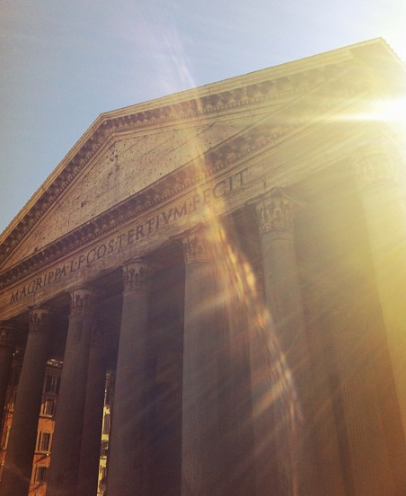
Pantheon The Pantheon’s round interior is shaped like a large cylinder, and it is covered by an enormous dome, the largest and widest ever constructed without support! Look up at the center of the dome, see the large open hole? It’s a huge eye, or oculus, that looks up to the sky.
When it rains (or snows) the sloped marble floor and small hidden drains gather the water that falls through the oculus. When the sun shines, the beam of light entering through the oculus hits the walls of the Pantheon in different spots at different times of day. You could actually use it as a huge clock. As you look around the inside of the monument, you can see seven large alternating niches (indented rooms) and one large one at the back. All the niches – semi-circular and rectangular – are chapels decorated with wonderful art. Although this place of worship started out as a temple where Romans could celebrate every deity (the Greek root pan– means ‘all’), today the Pantheon is a Roman Catholic Church. The niches house funeral monuments and tombs. Let’s take a look at some of them. The tomb of Vittorio Emanuele II – Italy’s first King – is in the middle. To the left of it are the tombs of Umberto I and Margherita di Savoia, more royalty. In fact, from 1870, the Pantheon was the burial-place for the Savoy family, the sovereigns that ruled Italy until 1946. On the left, there is another celebrated tomb, but the person buried here is not a king, rather a wonderful Renaissance painter, his name was Raffaello Sanzio, or Raphael. His burial monument portrays a beautiful woman, “la Vergine del Sasso,” the Virgin of the rock. It was Raffaello himself who asked his friend Lorenzetto, to sculpt her for his burial monument. During the Catholic celebration of Pentecost, rose petals are dropped through the oculus… a pretty sight!
Piazza della Rotonda.
La Barcaccia | The Sinking Boat
The fountain in Piazza di Spagna is called the Barcaccia (“ugly old boat”) because it portrays a sinking launch that is taking in water from stern to helm. The sculptor, Pietro Bernini (Gian Lorenzo’s father) created it under the commission of Pope Urban VIII in 1627. Bernini was purportedly inspired after seeing how the boats in the nearby port of Ripetta (one of Rome’s river moorages) had been washed up after a disastrous flood. The Barcaccia fountain has a double basin: one is the drowned boat, while the other is the river it is sinking in. The aqueduct that provides water to the fountain is the Acqua Vergine, an ancient Roman aqueduct still functioning today, bringing water to this part of the city. The pressure is so strong that water springs up naturally, without any mechanical device. The water shoots up high from a middle spout, and also fans out from the mouth of the solar figures on both ends of the boat. It also flows from jets into the bottom part and even spurts from the sides. The natural spring water is always icy cold and refreshing, proof of this are the many overheated tourists and locals drinking (or sometimes even dipping in) the water during summer.
Piazza di Spagna, at the foot of the Spanish Steps.
Palazzo De Cupis | The Ghost Hand
If you are lucky enough to be Piazza Navona on a moonlit night, and if you are a close observer, you could see a mysterious woman’s hand reflected in a dark window. The hand belongs to the beautiful Costanza De Cupis, who was famous during the 17th century for her splendid hands. Her hands were so famous and so beautiful that an artist her contemporary made a plaster cast of one of them, and people would visit the palazzo just to admire it. However, one day while embroidering, Costanza pricked her finger with a rusty needle, which caused an infection and soon after her death. From that moment on, according to legend, when the moon shines on the window of her room, the light that reflects on the glass reveals the shape of a small pale hand. Truth or illusion? Find out by looking closely at the windows of the Palazzo De Cupis…
Piazza Navona.
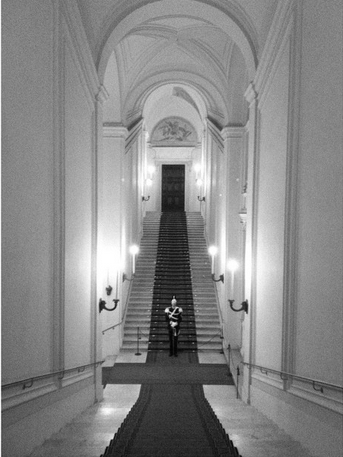
Corazzieri in Palazzo del Quirinale ©EleonoraBaldwin
Piazza del Quirinale | The Towering Corazzieri
All the climbing to get here will remind you that you are on one of the seven hills of Rome. This particular one, the Quirinal, takes its name from an ancient Roman temple dedicated to the god Quirinus. Perched on the summit of the Quirinale hill is the Presidential palace. It is huge! The Palazzo was built as a private residence for the Pope; later inhabited by the King of Italy who settled in, and now the President of the Republic lives here. Take a good look at the Presidential guards, the Corazzieri. They wear beautiful uniforms, sport elaborate swords and don strange golden helmets with long horse’s tails streaming down the back. The Corazzieri are a special police unit, who are all very tall and guard the Head of State. They must be over 6 feet tall to qualify! Generations of Corazzieri have been guarding the Palazzo del Quirinale, home to the various dignitary tenants for more than 500 years. If you are lucky, you might get to see the Corazzieri pass by on horseback, that’s when they are at their tallest! Stop in front of the Palazzo’s main entrance on the open piazza, and wait for the changing of the guard everyday around 3:30 p.m. It’s quite a show.
Also, be sure to take a look at the other two famous giants and their horses in the middle of the square, the white marble ones standing above the fountain. They are the mythological twins Castor and Pollux. Piazza del Quirinale.
Giardino Botanico | Rome Botanical Gardens
In this magical garden and its forests, paths and rolling hillsides, you can find a collection of more than 3500 species of rare plants, and discover amazing colors, shapes and perfumes. By walking down the many snaking gravel paths, you’ll encounter extravagant cacti, a bamboo forest, incredibly tall palm trees and tiny little dwarf palms, and some others that creep along like giant snakes. There is even a Soap Tree with leaves that lather up if you wet them and rub them between your hands.
If you want to see the oldest plant in the city, go past the Mediterranean Flora garden and look towards the big staircase. Here you will find a wise and beautiful sycamore (or plane) tree that is 400 years old! There are also two greenhouses that you should not miss. The first houses carnivorous plants, always hungry for insects and bugs; and the second holds flying orchids that are lighter and more delicate than butterflies. Finally, you can head over to the Rocky Garden, or the Japanese Garden to find bonsai trees. These trees are so little and so perfect in every detail, that you will look like a giant standing next to them. And before exiting, be sure to quietly tour the magic Garden of Aromas, where you can close your eyes and try to recognize plants by using only your nose!
Botanical Gardens Rome – Largo Cristina di Svezia, 24 | Tel. +39 06 49912436
41.895466
12.482324


